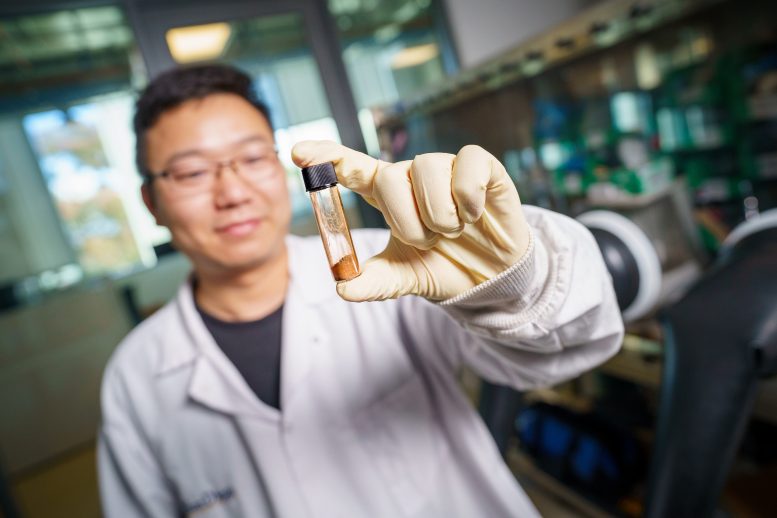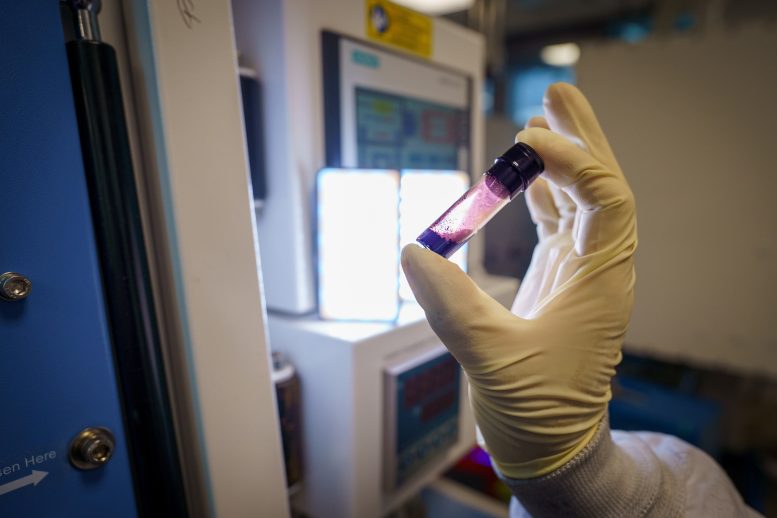
Researchers have moved one step closer to making solid-state batteries from lithium and sulfur a practical reality. A team led by engineers at the University of California San Diego developed a new cathode material for solid-state lithium-sulfur batteries that is electrically conductive and structurally healable—features that overcome the limitations of these batteries’ current cathodes.
The work was recently published in the journal Nature.
Solid-state lithium-sulfur batteries are a type of rechargeable battery consisting of a solid electrolyte, an anode made of lithium metal, and a cathode made of sulfur. These batteries hold promise as a superior alternative to current lithium-ion batteries as they offer increased energy density and lower costs. They have the potential to store up to twice as much energy per kilogram as conventional lithium-ion batteries—in other words, they could double the range of electric vehicles without increasing the battery pack’s weight. Additionally, the use of abundant, easily sourced materials makes them an economically viable and environmentally friendlier choice.
Challenges and Breakthroughs
However, the development of lithium-sulfur solid-state batteries has been historically plagued by the inherent characteristics of sulfur cathodes. Not only is sulfur a poor electron conductor, but sulfur cathodes also experience significant expansion and contraction during charging and discharging, leading to structural damage and decreased contact with the solid electrolyte. These issues collectively diminish the cathode’s ability to transfer charge, compromising the overall performance and longevity of the solid-state battery.
To overcome these challenges, a team led by researchers at the UC San Diego Sustainable Power and Energy Center developed a new cathode material: a crystal composed of sulfur and iodine. By inserting iodine molecules into the crystalline sulfur structure, the researchers drastically increased the cathode material’s electrical conductivity by 11 orders of magnitude, making it 100 billion times more conductive than crystals made of sulfur alone.

“We are very excited about the discovery of this new material,” said study co-senior author Ping Liu, a professor of nanoengineering and director of the Sustainable Power and Energy Center at UC San Diego. “The drastic increase in electrical conductivity in sulfur is a surprise and scientifically very interesting.”
Moreover, the new crystal material possesses a low melting point of 65 degrees Celsius (149 degrees Fahrenheit), which is lower than the temperature of a hot mug of coffee. This means that the cathode can be easily re-melted after the battery is charged to repair the damaged interfaces from cycling. This is an important feature to address the cumulative damage that occurs at the solid-solid interface between the cathode and electrolyte during repeated charging and discharging.
“This sulfur-iodide cathode presents a unique concept for managing some of the main impediments to commercialization of Li-S batteries,” said study co-senior author Shyue Ping Ong, a professor of nanoengineering at the UC San Diego Jacobs School of Engineering. “Iodine disrupts the intermolecular bonds holding sulfur molecules together by just the right amount to lower its melting point to the Goldilocks zone—above room temperature yet low enough for the cathode to be periodically re-healed via melting.”
“The low melting point of our new cathode material makes repairing the interfaces possible, a long sought-after solution for these batteries,” said study co-first author Jianbin Zhou, a former nanoengineering postdoctoral researcher from Liu’s research group. “This new material is an enabling solution for future high energy density solid-state batteries.”
The Future of Solid-State Batteries
To validate the effectiveness of the new cathode material, the researchers constructed a test battery and subjected it to repeated charge and discharge cycles. The battery remained stable for over 400 cycles while retaining 87 percent of its capacity.
“This discovery has the potential to solve one of the biggest challenges to the introduction of solid-state lithium-sulfur batteries by dramatically increasing the useful life of a battery,” said study co-author Christopher Brooks, chief scientist at Honda Research Institute USA, Inc. “The ability for a battery to self-heal simply by raising the temperature could significantly extend the total battery life cycle, creating a potential pathway toward real-world application of solid-state batteries.”
The team is working to further advance the solid-state lithium-sulfur battery technology by improving cell engineering designs and scaling up the cell format.
“While much remains to be done to deliver a viable solid-state battery, our work is a significant step,” said Liu. “This work was made possible thanks to great collaborations between our teams at UC San Diego and our research partners at national labs, academia, and industry.”
Reference: “Healable and conductive sulfur iodide for solid-state Li–S batteries” by Jianbin Zhou, Manas Likhit Holekevi Chandrappa, Sha Tan, Shen Wang, Chaoshan Wu, Howie Nguyen, Canhui Wang, Haodong Liu, Sicen Yu, Quin R. S. Miller, Gayea Hyun, John Holoubek, Junghwa Hong, Yuxuan Xiao, Charles Soulen, Zheng Fan, Eric E. Fullerton, Christopher J. Brooks, Chao Wang, Raphaële J. Clément, Yan Yao, Enyuan Hu, Shyue Ping Ong and Ping Liu, 6 March 2024, Nature.
DOI: 10.1038/s41586-024-07101-z
This work was supported in part by the U.S. Department of Energy (DOE) Advanced Research Projects Agency-Energy (DE-AR0000781), the U.S. DOE Office of Science (DEAC02-05-CH11231).